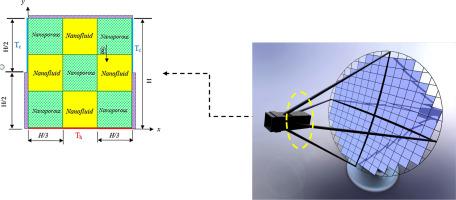太阳能聚光热系统纳米孔壳的熵产
IF 6.3
3区 工程技术
Q1 ENGINEERING, CHEMICAL
Journal of the Taiwan Institute of Chemical Engineers
Pub Date : 2025-07-18
DOI:10.1016/j.jtice.2025.106294
引用次数: 0
摘要
研究了多层纳米流体(swcnts -水)和纳米多孔介质填充的方形腔体在太阳能发电厂中的自由对流换热和不可逆性特性。该应用在聚光太阳能盘集热器内,反射吸收的热辐射反射到接收器(外壳)上。方法对达西数(10-5≤Da≤10-1)、多孔层孔隙度(0≤ε≤0.8)、瑞利数(103≤Ra≤106)、纳米颗粒体积分数(0≤φ≤0.06)等无量纲参数进行数值模拟。根据腔内纳米流体和纳米孔层的分布,研究了不同的情况。多孔层数及其在腔内的分布对流体流动速率和换热速率有显著影响。本研究的新颖之处在于,它是第一个在包含多孔和纳米流体层的方形外壳中通过流函数、等温线和熵效应研究自然对流的理论研究,这些层是纵向和横向的。当孔隙度接近0.63时,流动强度下降,尤其是在纳米流体与纳米孔的界面处。而且,Ra = 106引起自然对流的增加,从而引起Nu的上升,直到磁导率,ε = 0.4。在这个渗透性值(ε = 0.4)之后,随着孔隙率的上升,Nu形式开始下降。本文章由计算机程序翻译,如有差异,请以英文原文为准。

Entropy generation in nano-porous enclosure for solar concentrating thermal system
Background
Free convective heat transfer and irreversibility characteristics in a square-shaped cavity filled with multiple layers of nanofluid (SWCNT-water) and nano-porous media are studied for use in solar power plants. The application is within the concentrating solar dish collectors where the reflected absorbed thermal radiation reflected on the receiver (enclosure).
Methods
This study is done numerically for various dimensionless parameters, including Darcy number (10–5 ≤Da ≤10–1), the porosity of the porous layer (0 ≤ ε ≤ 0.8), Rayleigh number (103 ≤ Ra ≤ 106), and the nanoparticle volume fraction (0 ≤ φ ≤0.06). Different cases depending on the distribution of the nanofluid and nano-porous layers inside the cavity are studied. The number of porous layers and their distribution within the cavity have a remarkable impact on the rates of fluid flow and heat transfer.
Significant findings
The novelty point in the current study is that it is the first theoretical study that includes the study of natural convection through the stream function, isotherms and the entropy effect in a square enclosure that contains layers of porous and nanofluid, and these layers are longitudinal and transverse. The flow intensity drops as the porosity gets closer to 0.63, especially at the interface between the nanofluid and nano-porous. Moreover, Ra = 106 causes an increase in natural convection, which causes the to rise until permeability, ε = 0.4. The starts to fall as the porosity rises after this permeability value (ε = 0.4).
求助全文
通过发布文献求助,成功后即可免费获取论文全文。
去求助
来源期刊
CiteScore
9.10
自引率
14.00%
发文量
362
审稿时长
35 days
期刊介绍:
Journal of the Taiwan Institute of Chemical Engineers (formerly known as Journal of the Chinese Institute of Chemical Engineers) publishes original works, from fundamental principles to practical applications, in the broad field of chemical engineering with special focus on three aspects: Chemical and Biomolecular Science and Technology, Energy and Environmental Science and Technology, and Materials Science and Technology. Authors should choose for their manuscript an appropriate aspect section and a few related classifications when submitting to the journal online.

 求助内容:
求助内容: 应助结果提醒方式:
应助结果提醒方式:


